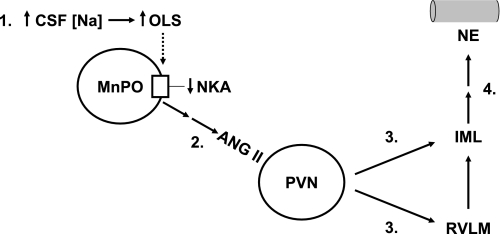Fig. 10.
Hypothetical sequence of events following increases in CSF [Na]. Step 1: increased production/release of OLS caused by increased CSF [Na] produces inhibition of the Na+-K+-ATPase (NKA) within the median preoptic nucleus (MnPO). Possible sensors of CSF [Na] are ventricular ependymal cells in the OVLT, SFO, and MnPO. The NKA inhibition in the MnPO results in: Step 2: increased activity of neuronal projections (either mono- or polysynaptic) from the MnPO to the parvocellular division of the paraventricular nucleus (PVN). This causes an increased AT1 receptor stimulation in this region of the PVN, presumably via the release of ANG II. Step 3: AT1 receptor stimulation in the parvocellular PVN causes activation of direct projections to the intermediolateral cell column (IML) of the spinal cord; or alternatively, these PVN neurons project to the rostral ventrolateral medulla (RVLM), which in turn projects sympathetic preganglionic fibers that pass through the IML. Step 4: Activation of the sympathetic preganglionic neurons in the IML tract ultimately culminates in enhanced release of NE at nerve terminals on vascular smooth muscle and other tissues. See discussion for further explanation, background, and references.

